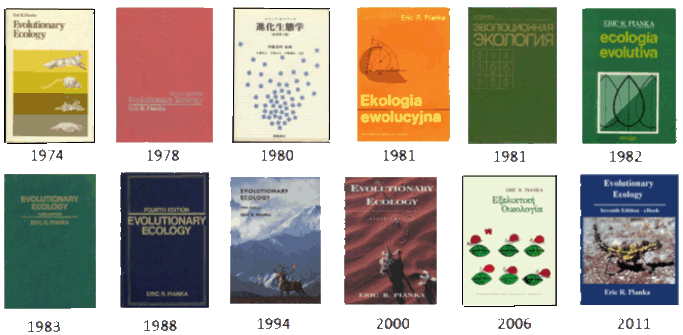|
Eric R. Pianka For this generation who must confront the shortsightness of their ancestors 

Citation Classic, Book Review Chapter 1 - Background Definitions and Groundwork, anthropocentrism, the importance of wild organisms in pristine natural environments, scaling and the hierarchical structure of biology, levels of approach in biology, domain of ecology, the scientific method, models, simple versus multiple causality, environment, limiting factors, tolerance limits, the principle of allocation, natural selection, self-replicating molecular assemblages, levels of selection, the urgency of basic ecological research Chapter 2 - Classical Biogeography Self-replicating molecular assemblages, geological past, classical biogeography, plate tectonics and continental drift Chapter 3 - Meteorology Major determinants of climate, local perturbations, variations in time and space, global weather modification Chapter 4 - Climate and Vegetation Plant life forms and biomes, microclimate, primary production and evapotranspiration, soil formation and primary succession, ecotones, classification of natural communities, interface between climate and vegetation, aquatic systems Chapter 5 - Resource Acquisition and Allocation Limiting factors, physiological optima and tolerance curves, energetics of metabolism and movement, resource and energy budgets, the principle of allocation, leaf tactics, foraging tactics and feeding efficiency, energetics of metabolism and movement, adaptation and deterioration of environment, heat budgets and thermal ecology, water economy in desert organisms, other limiting materials, sensory capacties and environmental cues, adaptive suites and design constraints. Chapter 6 - Rules of Inheritance Mendelian Genetics, nature versus nurture, selfish genes, population Genetics, Hardy-Weinberg equilibria, maintnence of variability, units of selection, genetic engineering Chapter 7 - Evolution and Natural Selection Agents of Evolution, Gene Flow, Genetic Drift, Segregation Distortion, Mutation, Differential Reproductive Success, types of natural selection, ecological genetics, speciation, reproductive isolating mechanisms, Galápagos finches Chapter 8 - Vital Statistics of Populations Individuals versus populations, population parameters, life tables and schedules of reproduction, net reproductive rate, reproductive value, generation time, stable age distribution, Leslie matrices, intrinsic rate of increase, demographic and environmental stochasticity, evolution of reproductive tactics, reproductive effort (parental investment), expenditure per progeny, patterns in avian clutch sizes, evolution of death rates and old age, joint evolution of rates of reproduction and mortality Chapter 9 - Population Growth and Regulation Population growth, population regulation, Pearl-Verhulst logistic equation, density dependence and independence, opportunistic versus equilibrium populations, r and K selection, population "cycles," cause and effect, metapopulations Chapter 10 - Sociality Use of space, home range and territoriality, evolution of sex, sex ratio, sexual selection and mating systems, fitness and the individual's status in the population, social behavior and kin selection, reciprocal altruism, parent-offspring conflict and group selection, game theory and evolutionary stable strategies, evolution of self deceit Chapter 11 - Interactions Between Populations Direct versus indirect interactions, complex examples of population interactions, mutualistic interactions and symbiotic relationships, indirect mutualisms and trophic cascades Chapter 12 - Competition Mechanisms of competition, Lotka-Volterra competition equations, competitive exclusion, balance between intraspecific and interspecific competition, evolutionary consequences of competition, laboratory experiments and evidence from nature, character displacement and limiting similarity, future prospects Chapter 13 - The Ecological Niche History and definitions, the hypervolume model, fundamental versus realized niche, resource matrices, niche breadth and overlap, niche dynamics, niche dimensions, evolution of niches, periodic tables of niches Chapter 14 - Experimental Ecology Design of experiments, controls, replicates, pseudoreplication, rocky intertidal experiments, other examples Chapter 15 - Predation and Parasitism Predation, predator-prey oscillations, "prudent" predation and optimal yield, theory of predation, functional and numerical responses, selected experiments and observations, evolutionary consequences of predation: predator escape tactics, aspect diversity and escape tactic diversity, parasitism, epidemiology, Darwinian medicine, microbiomes, coevolution, plant apparency theory, evolution of pollination mechanisms, symbiotic relationships Chapter 16 - Phylogenetics in Ecology Phylogeny, classification and systematics, phylogenetic systematics, vicariance biogeography, independent contrasts, the comparative method, evolutionary ecomorphology, ecological equivalents and convergent evolution Chapter 17 - Community and Ecosystem Ecology Systems and macrodescriptors, complex networks of interacting species, community organization, compartmentation, guild structure, trophic levels and food webs, biogeochemical cycles, principles of thermodynamics, secondary succession, transition matrices, the community matrix, pyramids of numbers, biomass, and energy, energy flow and ecological energetics, evolutionary convergence and ecological equivalents, ecotones, vegetational continuua, pseudocommunities, landscape ecology and macroecology, evolution of communities Chapter 18 - Biodiversity and Community Stability Saturation with individuals and with species, species diversity and species richness, equitability, latitudinal gradients in species diversity, diversity of lowland rainforest trees, types of stability, community stability Chapter 19 - Island Biogeography and Conservation Biology Classical biogeography, biogeographic "rules," species-area relationships, equilibrium theory of island biogeography, compression hypothesis, islands as ecological experiments: Krakatau, Galapagos finches and other examples, the taxon cycle, metapopulations, experimental biogeography, conservation biology, human impacts on natural ecosystems, hot spots of biodiversity, applied biogeography and the design of nature preserves References Go to Pianka Lab Homepage Last updated 21 October 2015 by Eric R. Pianka |